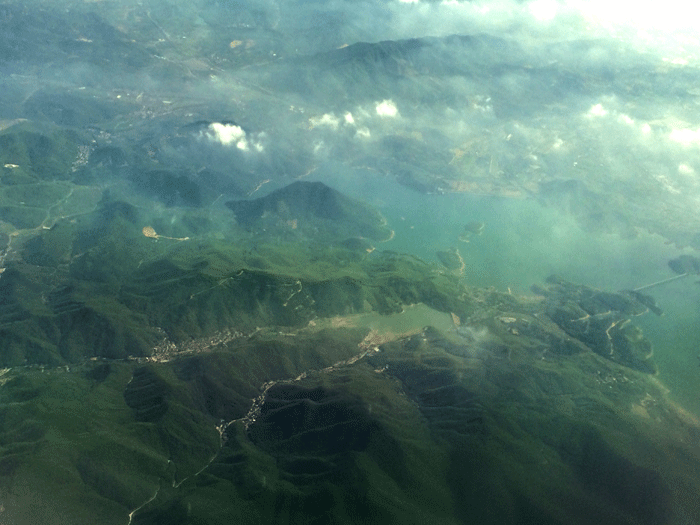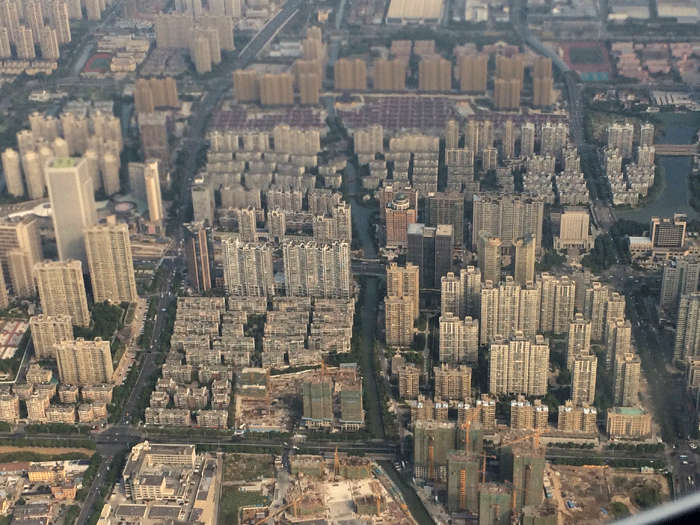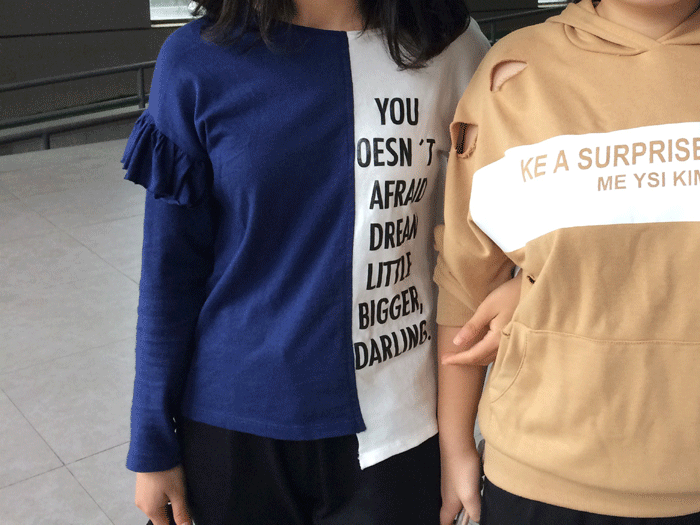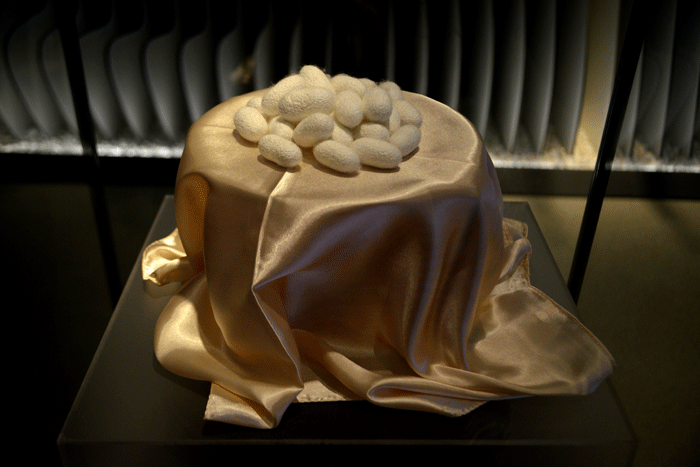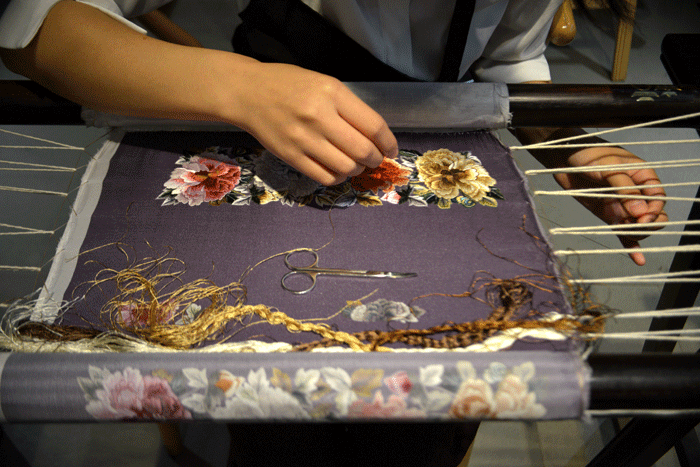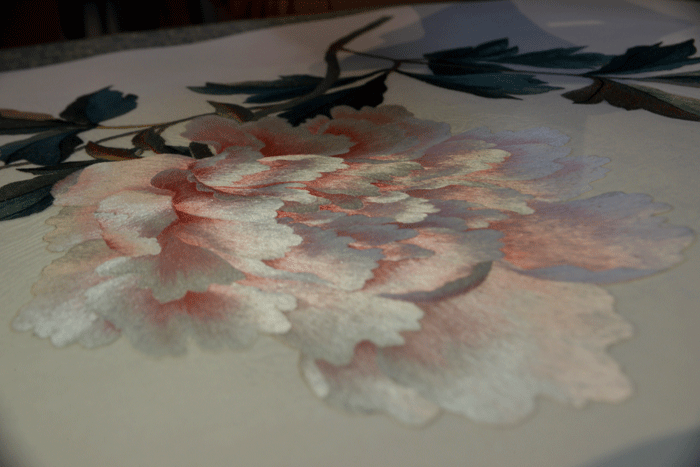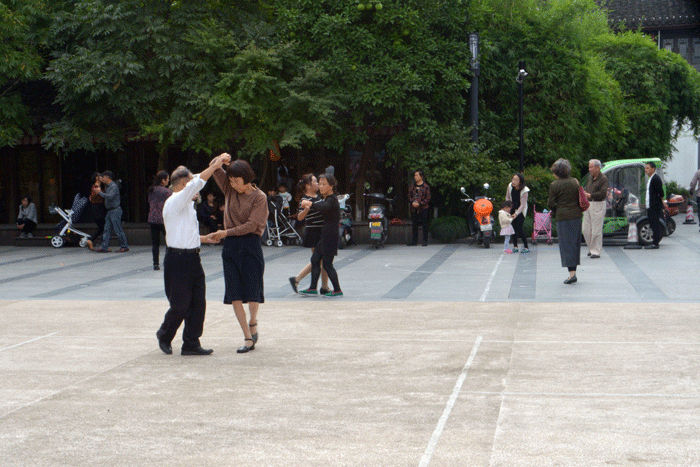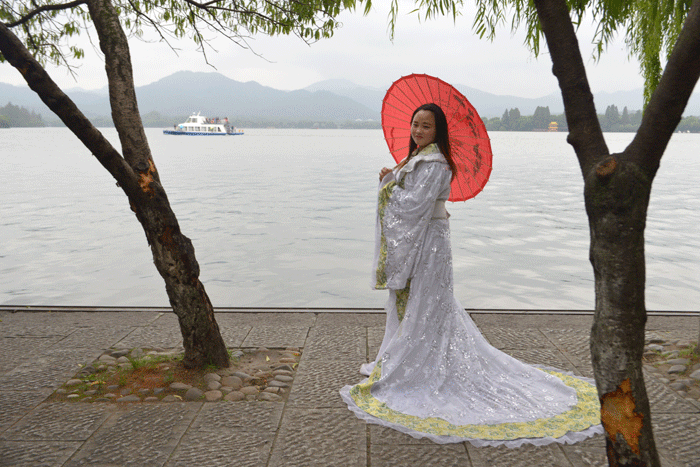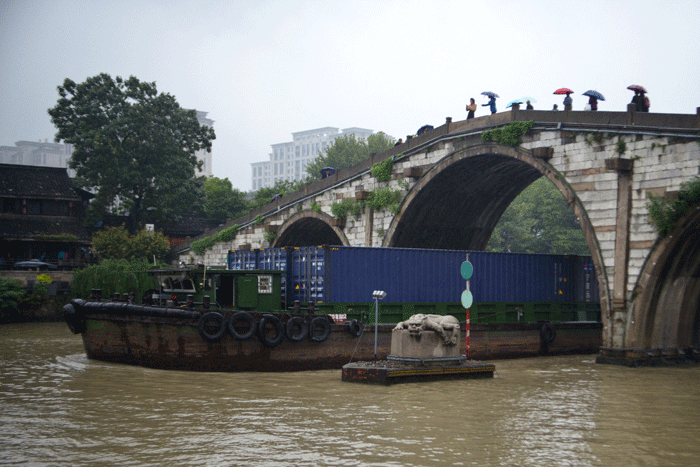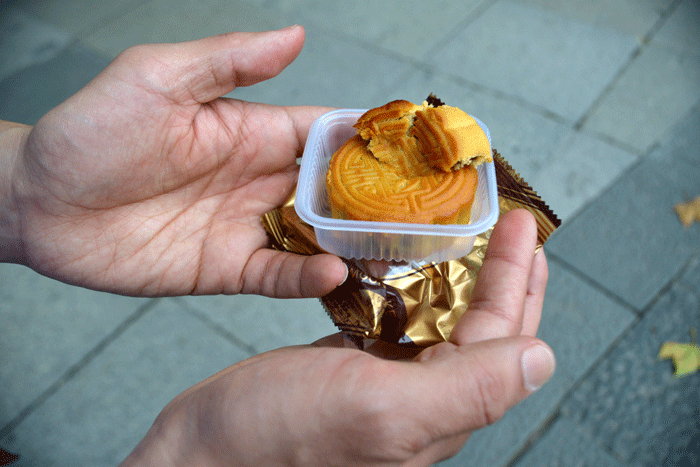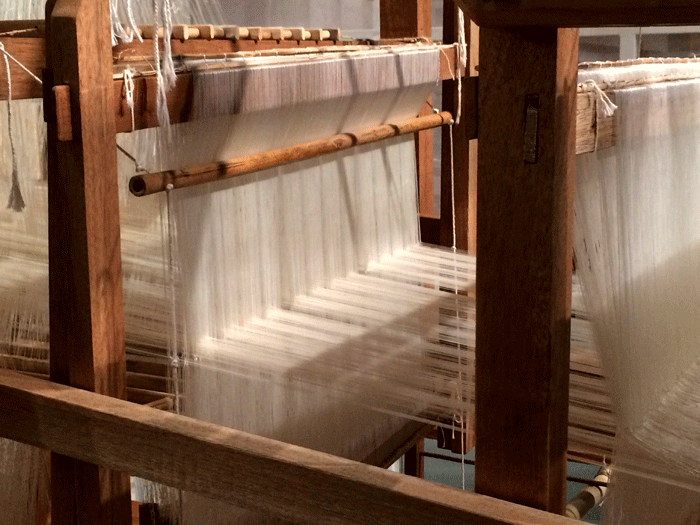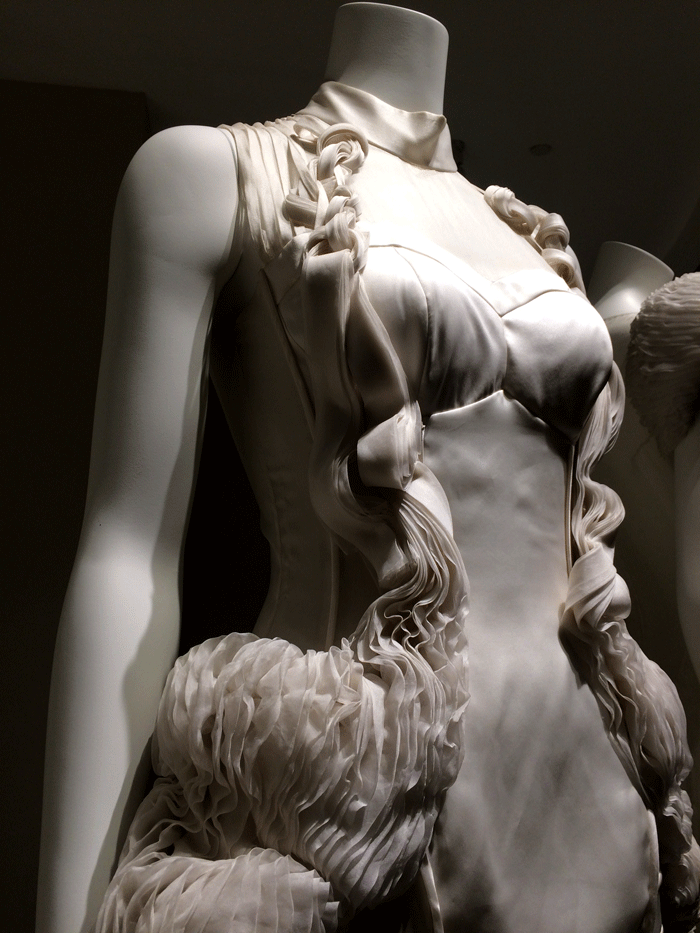Notes from a travel to HangZhou with Macclesfield Historian Dorothy Bentley Smith.
Part of an R&D program with Barnaby Macclesfield Festival funded by Arts Council England.
Travel funded by Artists Newsletter’s Travel Bursary.
Host organisation, Hangzhou Normal University.
The aim of this research is to create a digital artwork inspired by silk weaving, exploring silk as a metaphorical connecting material. It will connect people at the beginning of the Silk Road (Hangzhou/Hughou) with people at the end of the Silk Road (Macclesfield).
Tuesday 10 October
After a 5-hour night (we have flown around the globe fast to catch up with sunrise), and a very stiff neck, I am awakened by a lovely Dutch airhostess. I am enjoying my last Western breakfast, daydreaming through the window, when I spot mountains like I have never seen before. It’s as if someone ruffled a tablecloth placed on top of the earth, and the houses below are about to tumble. The earth has rippled to created folds that remind me of silk ribbons, what a nice welcome from the country of silk.
We are welcomed by Feng Xue Qin, our host at Hangzhou Normal University, and two lovely and pretty young students offer to take us to the Silk Market. A scary drive in a taxi with no seatbelt, horns beeping all around, and people on electric motorbikes whizzing passed us with no helmets. My health and safety customs are shattered right away!
We arrive in a busy shopping mall, buzzing with people and big green bags of goods being wrapped and unwrapped right in the middle of a 7-floor building, it gives me a sense of what an ancient silk market might have looked like, with lots of people bargaining and bartering silk for other goods. Dorothy thinks we might have swapped Blue Zaffra copper extracted from European mines for Chinese silk. All the colours we can see have been created form the ground, either with shades of Copper ores or plants cultivated for their colour. In England, purple was the colour used for the Bishop. Black was the hardest colour to make as it would easily fade away from the fibre.
We reach the top floor by lift and wander through rainbows of colours and patchworks of patterns, with silk scarves and garments varying in price from £1 to £100 depending on the quality of the silk. To be honest, at that point, I cannot see a great difference, but the girl can. Eyes are not enough to judge, touching and feeling is needed. I cannot understand what they say but I know when they are mentioning silk because in Chinese they say “ssssss”. It sounds as smooth and shiny as it looks.
I leave the market with a scarf for my mother, mother in law, grandmother and grandmother’s sisters. I wish I knew more women I could buy silk scarves for!
Tiredness is now hitting me, but we need to eat. Back on university campus we head for the canteen, desperate to find dumplings. Unfortunately (and obviously!), all the menus are written in Chinese, and the 2 girls have now left us… We suddenly spot a kiosk with food on display… saved! We don’t have to choose blind we can point!
A delicious soup with noodles and vegetables was just what we needed. Just a bit spicy, Dorothy scares me to death as she nearly chokes to death with the heat! I rush to ask for water but cannot find a way to describe it with my hands and facial expression only. I spot on the counter a soft juice of an orange colour, not orange juice, and I’ll never know what it was, but this cooled down the fiery Chinese dragon lodged in Dorothy’s mouth!
Wednesday 11 October
The National Silk Museum is a place where you can discover silk history through a series of ancient artifacts and displays, but most excitingly also see some real silk worms in action, eating away the mulberry leaves picked from the nearby trees. If you come close, you can touch and feel their soft white skin, it feels soft and dry, it reminds me of the texture of silk. They are quite large and majestic, standing now and then on their back legs to reach towards the sky. I can hear a monotonous munching orchestra as the eating orgy takes place under my eyes. Some of the worms have started to weave their cocoons, and I can see them looking half asleep through their thin shell. They look much calmer than the hungry ones.
Outside the museum, there is a lovely quiet man made park where school children take a break. I spot a few of them having fun with a piece of fabric that may well be a silk scarf. They play with it for ages, two children holding it while the others run underneath, screaming with joy as children do. They take it in turn to hold the cloth, and run around with it, letting it float elegantly behind them.
In the afternoon, I give a talk to some students from the Art theory, education, and aesthetic department. Their favourite artists are Monet and Van Goth and they cannot give me the name of a living artist. They knew I was coming but don’t know my work yet. They cannot access websites from outside China. The talk is set in a very formal way. I am in the middle and they are all looking at me. I decide to take them outside to do something that will challenge them a bit, so off we go in the rain. I ask one half of the students to close their eyes and the other half to lead them around the University gardens to experience it with other senses than their vision. I am not sure what they think of it, but I explain that for me art is not just about paintings or sculptures; it’s about challenging perceptions…
Thursday 13/Friday 14 October
Our host takes us on a 2-hour car journey to the place that is believed to be the origin of all silk making.
The archeological site of QuinShanYang was dug out 50 years ago. A scholar, on his return from his study in America discovered ancient potteries on the site, and pushed for a dig to be carried out. There, they found a small piece of silk, no bigger than a coin, which had been estimated to be from 4000BC. If this is true, this could be one of the earlier relics of silk ever found.
Trying to follow the sat nav, and asking many locals which way to go, we arrive right there, where the stone has been erected to mark the place where the relic was found. There, we find the happiest man I have ever met, the director and keeper of the piece of land where the archeological site now rests asleep, hidden under fields of grass and mulberry trees. He shows us mulberry leaves, and explains that the silk worms where first found wild in the mountains, all the way from China to India. There are many species of silk worms but the biggest ones are called Tussar.
A local community museum has been created near the site to showcase some of the potteries found there and an enlarged replica of the ancient piece of silk (the real one is preciously kept by Zhejiang Provincial Museum). A tall carved stone sculpture marks the village nearby as an ancient silk village. In the distance, I can see flakey grey walls, making a beautiful backdrop for the contrasting colourful clothes hung outside windows. I wish I could spend more time here…
Nearby shines the brand new Culture Exchange Centre – also called Hughou Ling Silk Institute. It stands proudly in a perfectly beautifully tamed landscape similar to a postcard and opens up on the Tai Lake. It is so peacefull, and feels very remote, but it is only a few minutes away from the hustle and bustle of Hughou with its busy traffic and tall tower blocks. Obviously well supported by the government, the museum has a luxurious and hyper polished feel about it, with many members of staff looking greatly smart. The beautifully crafted exhibition, with a bunch of cocoons carefully placed on a nest of weaved silk, and breath taking displays, makes my footsteps echo as no visitors are to be seen – yet.
We have a seminar with the Director of the museum, Ms Zhu, and the director of the Silk Research Institute. Referring to a Chinese book about ancient silk, Ms Zhu explains that silk was first created not for practical needs but for spiritual needs, as people had already found ways to dress and stay warm with animal skins. She believes people thought that metamorphosis was a metaphor for the process of life. Silk weaving was more of a philosophy, thinking about where we come from and where we are going as human beings. Silk was first only used for the bodies of the dead. They were wrapped up like cocoons, ready to metamorphose into their spiritual after life. But only the wealthiest people could afford this after life…
The lands where mulberry trees grew were also thought to be sacred, with magical and fertile powers. People held ceremonies there, for example for women who could not conceive. The Chinese written representation of silk consists in two symbols, one represents a worm, and above it the other one represents the sky, as if the silk worm had been brought to life on earth underneath the heavens.
Later on, silk became used for religious ceremonies and was then made more and more popular across the layers of society.
Hughou is named the lake city, with many rivers running through it that are now hidden underneath the growing urban landscape. People believe it is situated right underneath the heavens, that this place is very special. Situated between Hangzhou, Shangai and Nanjing, in a wetland surrounded by a lake, a river leading to the nearby sea and a grand canal, it seems like the perfect place for the origin of silk production to rise. And maybe it is true that it is the happiest place on earth… I have not stayed long enough to check if this is true. But if this is paradise, what a beautiful coincidence to realise that the mill in Macclesfield containing a grand collection of working looms happens to be called Paradise Mill. This trip is strangely becoming more and more meaningful and mystical…
The Exchange Cultural Centre is welcoming us like queens (Dorothy strangely looks like the queen A LOT, especially here). Luggage are carried, mulberry tea is served, and a deliciously weird banquet is displayed on a large round table with spinning tray. I bravely try the wonderful dishes traveling past my eyes, but I am not feeling courageous enough to put any of the mini shrimps, tales flickering in their bowl as if calling for a last attempt to freedom, anywhere near my plate or my mouth! At least the food is definitely fresh!
I am loving the watermelon juice. My glass is magically refilled every time I drink any. Its feels like I have drunk a gallon and my glass is still full to the top.
Saturday 15 October
So far I visited two beautiful museums, but really, I like movement, people. I have met with arts students, but really I want to meet artists, makers… My translator, Peter, who has spent 1 year in Manchester and loves goat cheese and Belgium biscuits (what a small world!), has organised for me to meet someone at Yihui Creativity Silk and Embroidery Art. I think to myself this is going to be another museumified place. But when we arrive, we are warmly welcomed by the sunny face of Yihui herself, and I feel creative energy shinning at me straight away. This place is absolutely AMAZING. There are people everywhere, families with children running around, noise, lots of people making stuff everywhere.
Yihui’s organisation is a charity aiming to preserve what she calls the endangered specie that is silk embroidery. She explains that young people are not interested in learning this trade, as it is time consuming. So they teach this ancient skill to deaf young girls, who proudly show us their creations. I think this is so wonderful. People can watch them at work and talk to them. One of them kindly tries to unwind a piece of thread she is using to show me that it is made of 16 strands of silk thread. What they are making is beautiful, their designs shine as they move their creations under the light.
All around, makers passionate about what they do, make and sell their creations, demonstrating traditional skills such as bamboo weaving, wood sculpting, umbrella making… through contemporary creations. The government funds this place and the rent is free. Makers sell their objects, but Yihui tells me that the pay is quite small, they do it because they have a passion for what they do.
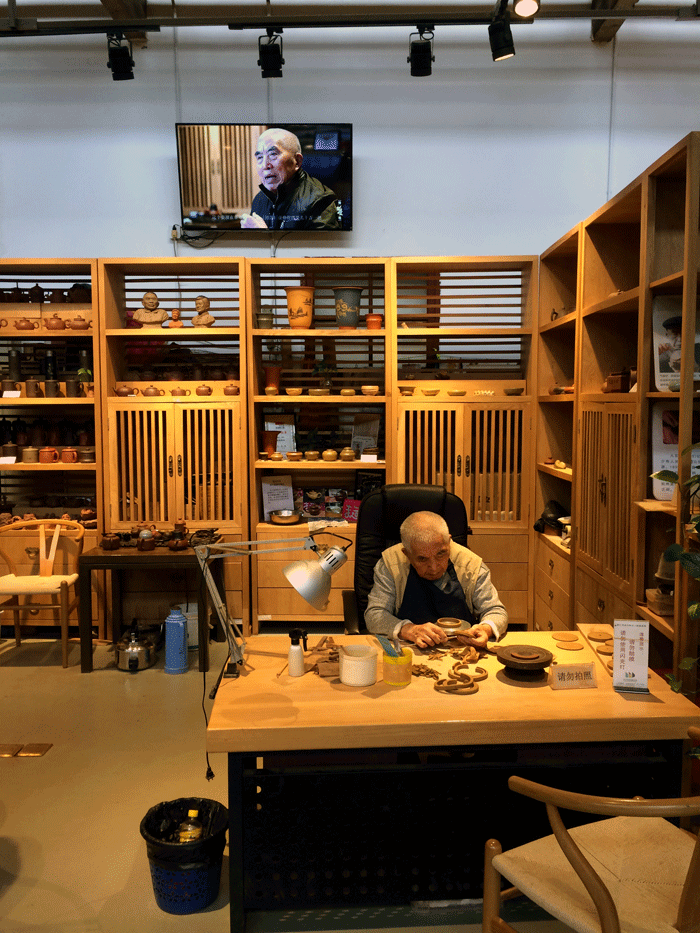
As I look up I can see we are in a very old building. This is an old silk warehouse, situated by the Grand Canal, a huge man made canal that used to connect HangZhou all the way to Bejing. This building is probably where the early silk trades, and the Silk Road, stemmed from. We are near the Dongxin Bridge, which is situated where the old city used to end.
I feel at home here. I’d love to stay here for a while… Oh, and people dance in the street here!
Next meeting: CAA art gallery. I meet the director and the curator. No direct words can be spoken without my translator but hands are shaken and eye contacts are made. They like my ideas of linking people from England to China through a digital piece of work… They tell me that their Art Gallery brings artist from all over the world for temporary exhibitions. The current exhibition focuses on drawing, all in black and white. Interesting to see that groups of students gather around the most unusual drawings rather than the more traditional ones.
I love Chinese Fashion, and I finally get to see some interesting looks here, you can spot the artists with their unexpected combinations of clothes, often linking traditional patterns of swirls and dragons with more contemporary cuts.
Despite having drunk three cups of coffee in a row during my last meeting, tiredness is catching up again. I could not sleep last night. My body has gone back to UK time. I am tired now but I bet I can’t sleep tonight. Can’t trick a brain with a clock! A trip to West Lake is what I need.
There, I see a girl posing in a beautiful white dress for a photo-shoot. There is a local legend here, of a white water snake who fell in love with a human and turned herself into a beautiful lady to seduce him. Like most Chinese love stories, this turns into a tragedy, but I have forgotten the end of the story, I will find out.
Sunday 16 October
We decide to take a ride on the Grand Canal, like silk traders would have done. The boat is like the local bus. For £0.45, you get from A to B without having to risk your life in the constant flow of fast vehicles that inundates the city all through the day.
Someone shares a mooncake with me. I am lucky to see one, as the moon festival is over now. It happens early October, when the moon is full and the biggest and brightest of the year. It becomes a symbol for perfection and life cycle. Families gather as we would for Christmas to have a big meal together and share moon cakes.
Monday 17 October
A visit to the Weaving Gallery at the National Silk Museum reminds me of my reason for being here. I want to understand what it is that makes us create a fabric such as silk. Its production is so complex, from the growing of the mulberry tree, to the domestication of the worms, the unwrapping of the cocoon, the twisting, the diverse methods of dying and weaving….
My fascination for the loom machines grows as I enter a room containing machineries as complex and large as small ships. Thousands of threads fed by hand, one by one, in pin holes, sit perfectly parallel to each other to create a ghostly fabric. Silk to me looks so much like hair… like the white hair of my beloved grandmum… Here it’s as if God had taken a hair to recreate a skin… Some machines are threaded with natural silk threads varying from white to yellow and ocre. One is covered in bronze threads, making the silk shine like the polished wood of the loom stretching it.
But it’s in the Chinese and Western Fashion Galleries that I find an answer. Here, we can see how throughout the centuries and throughout cultures we have tried to extend the body, to reach perfection and beauty, to take the skin to either a deeper level (through addition of fleshiness and unraveling of levels, as if to give the body extra layers of flesh to be uncovered, and layers of meanings…) or a more spiritual level (through transparency, airiness, and the blurring of the body’s boundary…).
In the Chinese and Western Fashion Galleries we can see how throughout the centuries and throughout cultures we have tried to extend the body, to reach perfection and beauty, to take the skin to either a deeper level (through addition of fleshiness and unraveling of levels, as if to give the body extra layers of flesh to be uncovered, and layers of meanings…) or a more spiritual level (through transparency, airiness, and the blurring of the body’s boundary…) The search for perfection and beauty through silk makes a bit more sense now. I believe it has a lot to do with skin. Detailed weaved patterns remind me of the pores of the skin, embroidery on hats look like perfectly combed hair, deep red velvet under layers look like open flesh.
We meet with the Museum director Pr Feng Zhao. He is a big fish in China, as he is also the Deputy of the National People’s Congress. He explains: “The World Heritage Committee deems that the Silk Road has been the road of integration, exchange and dialogue between the East and the West and has made significant contribution to the common prosperity of mankind for nearly 2000 years. In recent years, Chinese president Xi Jinping initiated to build “the New Silk Road Economic Belt” and “the 21st Century Maritime Silk Road”, setting up a new layout for China’s overall opening-up, and promoting the peaceful development of different regions around the world.”
Before we go, I want to go and see the silk worms again to film them, and my camera is about to run out of battery. As we rush towards the house where they are kept (by a friendly old man), I cannot believe it, they have disappeared. I draw a worm on a piece of paper to ask the man where they have gone. He points at a tray on the floor, and here are their cocoons, completed. They have started their metamorphosis… and I wonder what they must look like in there…
Unfortunately, for silk production, this is the stage where they would be put in boiling water, as the opening of the cocoon would break the singular silk thread. Only a few will make it to the butterfly stage for reproduction.
Tuesday 17 October
Before I go home, there is one last thing I have to do. I bought on a market a beautiful kite that looks just like a Tussar, the wild silk moths. I go to the 9th floor of the hotel to make it fly. There isn’t much wind in Hangzhou, but a small breathe makes him lift off above the city.

